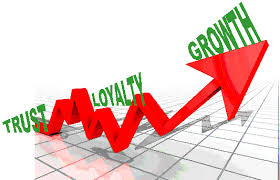 Increasingly, businesses are realizing that their greatest asset is their customer base.
Increasingly, businesses are realizing that their greatest asset is their customer base.
The old idea, put forward by many managing directors and human resource specialists over the years, that “our people are our greatest asset” is being questioned.
After all, employees with their annual leave, scheduled days off, and long list of generous benefits are a liability for any business that can cost substantial money. Customers are the people who can build the income of the entity.
Once you start thinking of your customers as an asset, it is then only logical to start thinking about what your business should be doing to keep them coming back for repeat purchases over the longer term.
The retention of customers and the frequency of their purchasing can very often determine whether you stay in business. If they maintain a good opinion of your product or service and provide that all-important word of mouth advertising, suddenly you can find that sales figures are on the up and up.
With customers and their retention being so important, managers and business owners need to understand the value that customers see in the product or service the business has on offer. Then the next step is to leverage that value over time in order to maintain and enhance profitability.
In many businesses repeat purchases produce as much as 90 percent of profit. Clearly managers and marketing specialists should be doing all they can to dream up ways of encouraging repeat buying.
The local car wash proprietor who offers “fifth wash free” is attempting to provide an incentive that attracts repeat buyers. As well, this simple loyalty initiative rewards loyal customers.
Probably there are few small and medium-sized businesses where managers have a handle on just how many customers they lose. According to author Frederick Reicheld in ‘The Loyalty Effect’, US corporations on average lose half their customers every five years.
Disaffected customers can do a great deal of harm to a business. Their criticism and disaffection can be so easily spread to an eagerly listening base of potential customers. You can be losing business without even knowing.
Losing longer-term customers can cost a business dearly. Even where the organization is able to replace lost customers with newly acquired customers the damage remains. The company loses because new customers are not as profitable as old customers due to the cost of acquiring them and the up-front servicing costs.
In addition, it can take new customers a long time before they start purchasing at the rate of the long-term customer whom they replace.
In many businesses, customers can be streaming out the door while there is too much measurement and analysis of profit and not enough attention given to the creation of customer value. It is often not enough to survey customers and find out what they are saying. It is far more valuable to accurately track lifetime purchases.
Precise information about what customers actually do is infinitely more useful than data purporting to explain buyer intentions that comes out of phone research or mail questionnaires.
Once detailed purchasing behavior is known, almost always the Pareto Principle becomes visible where 20 percent of customers will be producing 80 percent of profits. However, this 80/20 rule should be thought of as a guide only.
At this point, businesses can start coming to terms with how many satisfied and profitable customers they keep.
It is critical to look at the question, “which of our customers are the most profitable and have been most loyal and which can be defined as core customers?” Once you identify your core customers, then you have to invent ways of treating them as gold.
Not all customers are equal. Your loyal customers who keep coming back are the ones you have to bend over backwards for.
In all your marketing efforts, it is good to be very clear about the sort of customers you want to attract.
Copyright 2003, RAN ONE Inc. All rights reserved. Reprinted with permission from www.ranone.com

 Chris’ combination of academic credentials, career experience and temperament ideally suit his calling as a business development advisor. Clients say he has a mind for business and a heart for service.
Chris’ combination of academic credentials, career experience and temperament ideally suit his calling as a business development advisor. Clients say he has a mind for business and a heart for service.